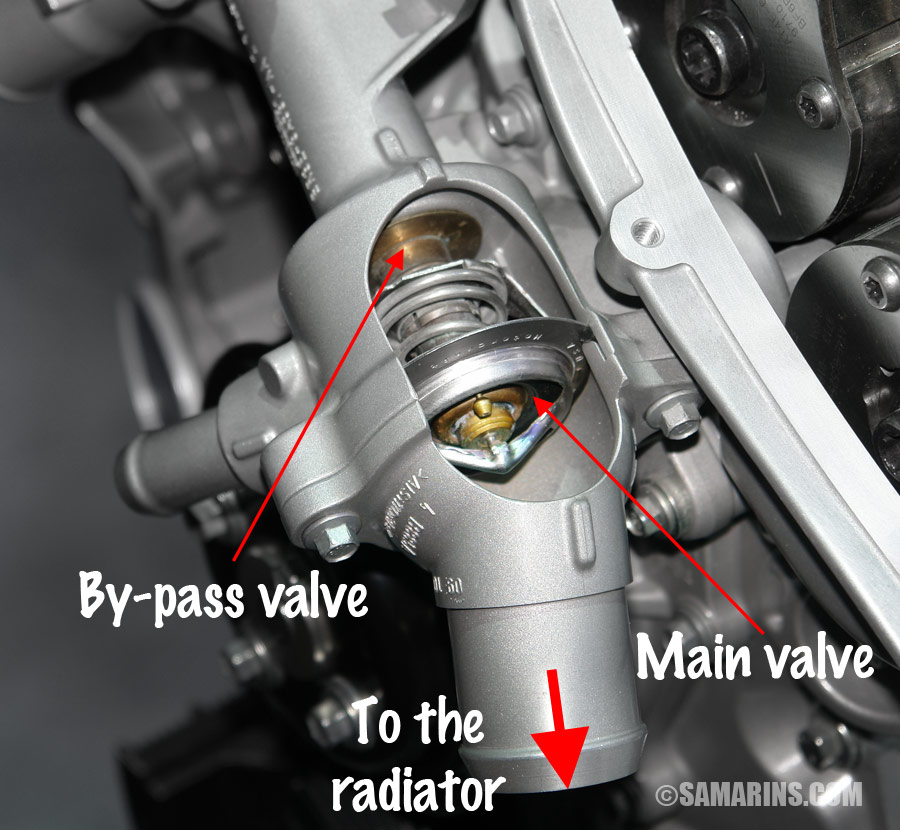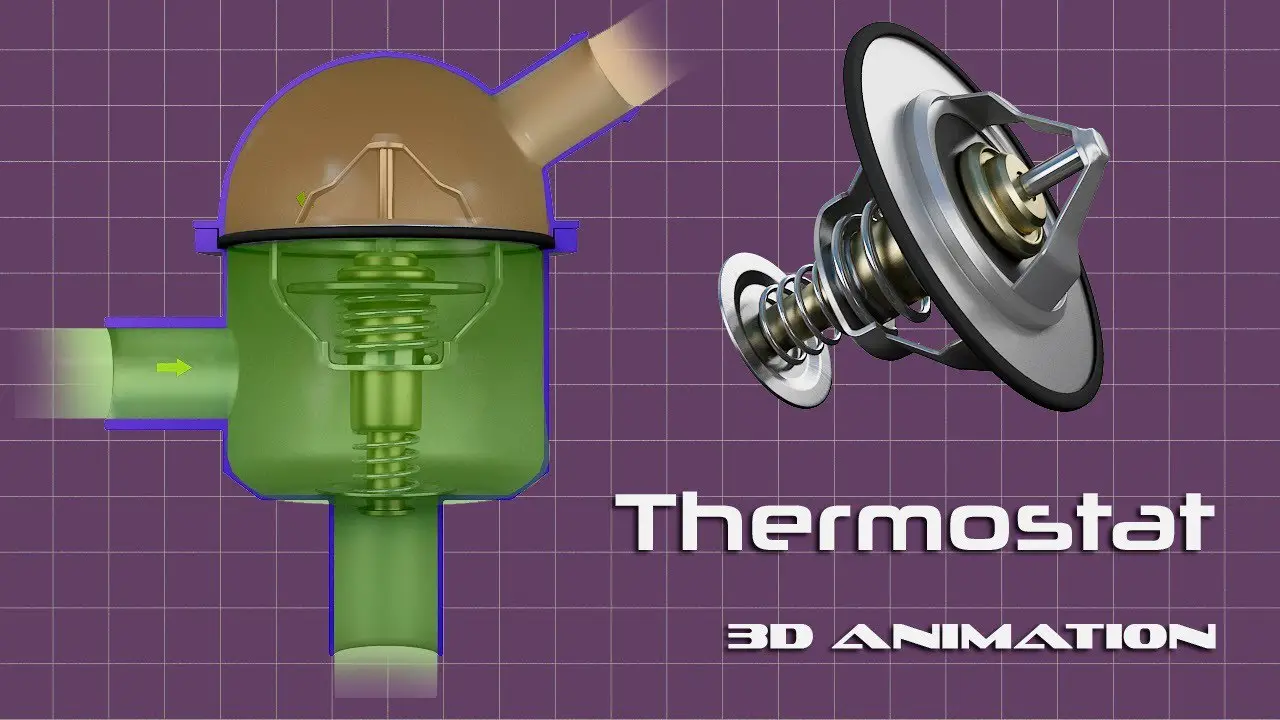Check Best Thermostat Pricing in Amazon
** As an Amazon Associate, I earn from qualifying purchases.
An auto thermostat controls your car’s engine temperature. It opens and closes to regulate coolant flow.
This ensures the engine runs efficiently and prevents overheating. A car’s thermostat might seem like a small part, but its role is crucial. It ensures your engine stays at the optimal temperature, allowing it to perform well and avoid damage.
When the engine is cold, the thermostat stays closed, preventing coolant from flowing. As the engine heats up, the thermostat gradually opens, letting coolant in to absorb excess heat. Understanding how this tiny component works can help you appreciate its importance and keep your vehicle running smoothly. In this blog post, we’ll explore the workings of an auto thermostat and explain why it’s key to your car’s performance.
Introduction To Auto Thermostats
Auto thermostats regulate engine temperature by opening and closing at set temperatures. They ensure the engine runs efficiently. This prevents overheating or overcooling.
Auto thermostats are vital components in vehicles. They ensure the engine runs efficiently. They manage the engine’s temperature. Without them, engines could overheat or not reach optimal temperature. Cars depend on thermostats to keep the engine in good condition. This section will help you understand their importance and basic functionality.Importance Of Thermostats
Thermostats keep engines from overheating. An overheated engine can cause serious damage. It may lead to costly repairs. They also help engines reach the correct operating temperature. Engines run better at certain temperatures. Proper temperature improves fuel efficiency. It also reduces emissions.Basic Functionality
Thermostats control the flow of coolant. They manage when coolant enters the engine. When the engine is cold, the thermostat stays closed. This helps the engine warm up quickly. As the engine heats up, the thermostat opens. This lets coolant flow through the engine. It helps maintain a steady temperature. The thermostat opens and closes automatically. It responds to temperature changes in the engine. In short, auto thermostats are crucial. They keep engines running at the right temperature. This ensures the vehicle works efficiently and lasts longer. “`
Credit: www.certifiedautoca.com
Key Components
The auto thermostat is a key part of your car’s cooling system. It controls the engine temperature. Let’s explore its key components. Understanding these helps in maintaining your car better.
Thermostat Housing
The thermostat housing is a cover. It sits on the engine. This housing holds the thermostat in place. It connects to the radiator hose. The housing is made of metal or plastic. It prevents leaks in the system. If damaged, it can cause overheating.
Temperature Sensor
The temperature sensor is vital. It measures the engine’s heat. This sensor sends data to the thermostat. The thermostat then knows when to open or close. A faulty sensor leads to incorrect readings. This can cause engine damage. Regular checks are important.
Working Principle
The auto thermostat is a key component in your car’s cooling system. It regulates the engine’s temperature by controlling the flow of coolant. Let’s dive into the working principle of this essential device.
Opening And Closing Mechanism
The thermostat has a valve that opens and closes to regulate coolant flow. It uses a wax pellet that expands and contracts with temperature changes. When the engine heats up, the wax melts and expands, pushing the valve open.
As the engine cools down, the wax contracts, closing the valve. This cycle ensures your engine operates within the optimal temperature range. Have you ever wondered why your car doesn’t overheat on long trips? The thermostat is likely doing its job.
Role Of Coolant
Coolant plays a significant role in the thermostat’s function. It absorbs engine heat and transfers it to the radiator. The thermostat controls when the coolant flows to the radiator.
This process ensures the engine runs efficiently. Imagine driving without this regulation—your engine would either overheat or run too cold. Have you checked your coolant levels lately? It’s a small step that keeps your thermostat and engine in top shape.
Understanding how your car’s thermostat works can save you from many headaches. Next time you pop the hood, take a moment to appreciate this small but mighty component.
Types Of Auto Thermostats
Auto thermostats regulate the engine’s temperature by controlling coolant flow. There are different types of auto thermostats. Each type works in its unique way. Understanding these types can help you maintain your car better.
Wax Pellet Thermostats
Wax pellet thermostats are the most common type. They use a wax pellet inside a cylinder. When the engine heats up, the wax melts. It expands and pushes a rod. This rod opens the valve, allowing coolant to flow. When the engine cools, the wax solidifies. The rod retracts, closing the valve. This simple mechanism is reliable and effective.
Electronic Thermostats
Electronic thermostats use sensors and a computer. These sensors monitor the engine’s temperature. The computer processes this data. It then adjusts the thermostat accordingly. This type offers more precision. It can respond quicker to temperature changes. Modern cars often use electronic thermostats. They help improve fuel efficiency and reduce emissions.
Installation Process
Installing an auto thermostat might seem daunting, but it’s easier than you think. With the right tools and guidance, you can do it yourself. Let’s break down the process into manageable steps.
Necessary Tools
Before you start, gather all the necessary tools. Having everything on hand will make the process smoother and quicker.
- Wrench set
- Screwdrivers
- Coolant
- Thermostat gasket
- Container for old coolant
- Rags
- Gloves
These tools are essential for a successful installation. Trust me, you don’t want to get halfway through and realize you’re missing a key tool. That happened to me once, and it was frustrating!
Step-by-step Guide
Now that you have your tools ready, let’s dive into the installation process. Follow these steps carefully:
- Cool Down the Engine: Ensure the engine is completely cool before starting. This is crucial for your safety.
- Drain the Coolant: Place a container under the radiator and remove the radiator cap. Open the drain plug and let the coolant flow out.
- Locate the Thermostat Housing: It’s usually found at the engine end of the upper radiator hose. Detach the hose from the housing.
- Remove the Thermostat Housing: Use a wrench to remove the bolts holding the housing. Carefully lift the housing off. You might need to gently tap it if it’s stuck.
- Take Out the Old Thermostat: Note how it’s positioned before removing it. This will help you place the new one correctly.
- Clean the Housing: Use a rag to clean any residue from the housing. This ensures a good seal for the new thermostat.
- Install the New Thermostat: Place the new thermostat in the housing, ensuring it’s in the same position as the old one. Install the new gasket.
- Reattach the Housing and Hose: Bolt the housing back in place and reattach the radiator hose. Ensure everything is tight and secure.
- Refill the Coolant: Add new coolant to the radiator. Check for leaks and ensure the coolant level is correct.
- Start the Engine: Run the engine and monitor the temperature gauge. Check for any leaks and ensure the thermostat is working correctly.
Installing an auto thermostat isn’t just about following steps; it’s about understanding each step’s purpose. Why do you think ensuring a proper seal is so crucial? It prevents leaks and keeps your engine running efficiently.
Check Best Thermostat Pricing in Amazon
** As an Amazon Associate, I earn from qualifying purchases.
Remember, taking your time and paying attention to detail will make this process much smoother. Have you ever tried installing an auto thermostat yourself? Share your experiences in the comments below!

Credit: www.samarins.com
Common Issues
Auto thermostats play a crucial role in regulating your car’s engine temperature. They help maintain the optimal temperature for your engine’s performance. But, like any part, they can face issues. In this section, we’ll explore common problems that can affect your thermostat. Understanding these issues can help you troubleshoot and maintain your vehicle better.
Overheating Problems
Overheating is a common issue with auto thermostats. If your thermostat gets stuck in the closed position, it won’t allow coolant to flow. This restriction leads to a rise in engine temperature. An overheating engine can cause serious damage. It’s essential to address this problem quickly. Checking the thermostat is a good starting point.
Coolant Leaks
Coolant leaks can also stem from thermostat issues. A faulty thermostat gasket can cause coolant to leak. Leaks reduce the efficiency of your cooling system. Low coolant levels can lead to overheating. Regularly inspect your engine for signs of coolant leaks. Early detection can save you from more significant problems.
Maintenance Tips
Maintaining your car’s thermostat is crucial for optimal engine performance. Without proper maintenance, your car’s thermostat could fail, leading to overheating or poor fuel efficiency. Here are some easy tips to keep your car’s thermostat in good shape.
Regular Inspections
Check the thermostat regularly. Look for signs of wear and tear. Ensure there are no leaks around the thermostat housing. Inspect the hoses connected to the thermostat. They should be free of cracks and holes.
Cleaning And Replacement
Clean the thermostat housing periodically. Dirt and grime can affect its performance. Use a soft cloth or brush to remove debris. If cleaning does not improve its function, consider replacing it.
Replace the thermostat if it shows signs of malfunction. A malfunctioning thermostat can cause the engine to overheat. Always use a thermostat that is compatible with your car’s make and model.
Future Of Auto Thermostats
The future of auto thermostats is bright and filled with promise. With technology advancing rapidly, these devices are becoming smarter and more efficient. Soon, auto thermostats will do much more than regulate temperature. They will enhance the overall driving experience and improve vehicle efficiency.
Technological Advancements
Auto thermostats are now using advanced materials and designs. These improvements increase their durability and precision. Modern thermostats can handle more extreme temperatures. This ensures your engine runs smoothly in all conditions.
Another breakthrough is the use of sensors. These sensors monitor various engine parameters in real-time. They help the thermostat respond quickly to changes. This results in better performance and fuel efficiency.
Integration With Smart Systems
Future auto thermostats will integrate with smart vehicle systems. These systems communicate with other car components. For example, the thermostat will work with the engine control unit (ECU). This collaboration optimizes engine performance and reduces emissions.
Smart thermostats will also connect to mobile apps. Drivers can monitor their vehicle’s temperature remotely. They can receive alerts about potential issues. This proactive approach can prevent breakdowns and extend the vehicle’s lifespan.

Credit: www.youtube.com
Frequently Asked Questions
Is It Better To Leave Thermostat On Auto?
Yes, leaving the thermostat on auto is better. It maintains consistent temperatures and improves energy efficiency.
What Does The Auto Setting On A Thermostat Do?
The auto setting on a thermostat automatically controls heating and cooling based on your set temperature. It maintains comfort efficiently.
How To Tell If Your Car Thermostat Is Working Properly?
Check if the engine warms up within 10-15 minutes. Observe the temperature gauge; it should stay steady. Verify heater output; hot air indicates proper function.
How Does Honeywell Thermostat Auto Mode Work?
Honeywell thermostat auto mode adjusts heating and cooling based on your set temperatures. It maintains comfort by switching between modes automatically.
Conclusion
Understanding how an auto thermostat works is crucial for car maintenance. It regulates engine temperature, preventing overheating. This simple device opens and closes to control coolant flow. A functional thermostat ensures your engine runs smoothly. Regular checks can save costly repairs.
Remember, a well-maintained car lasts longer. So, keep an eye on your thermostat. It’s a small part but plays a big role. Stay informed and keep your vehicle in top shape.
Check Best Thermostat Pricing in Amazon
** As an Amazon Associate, I earn from qualifying purchases.


